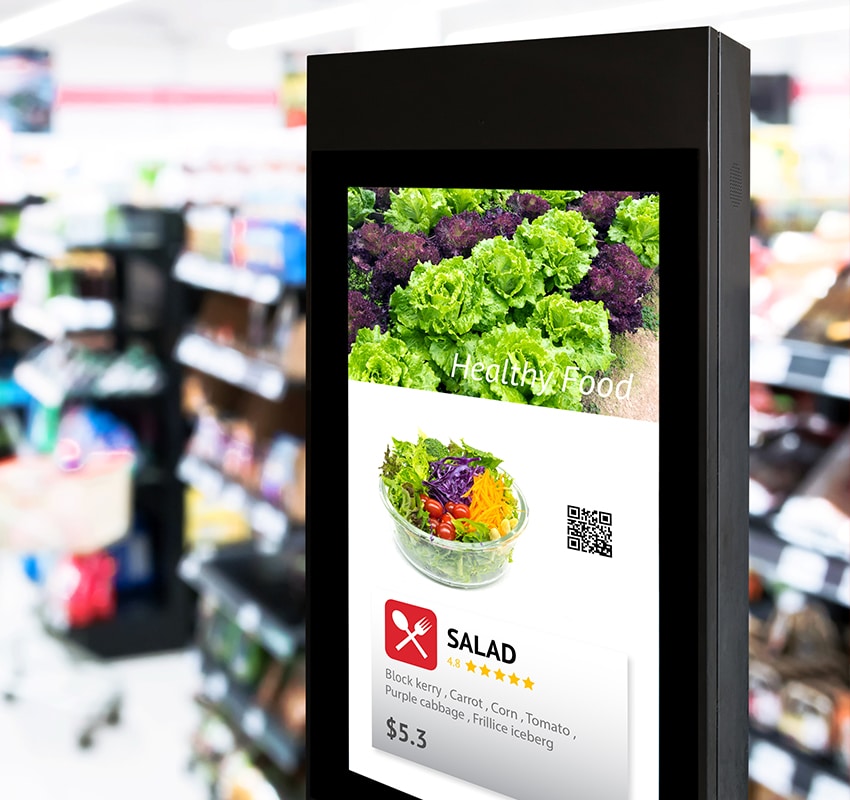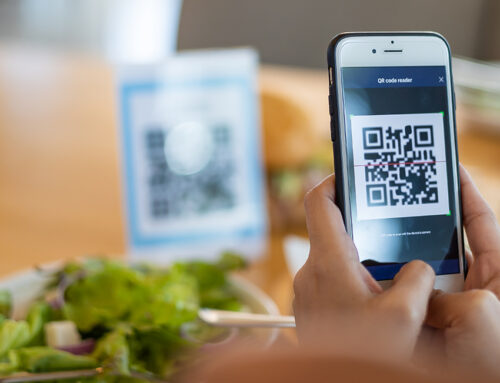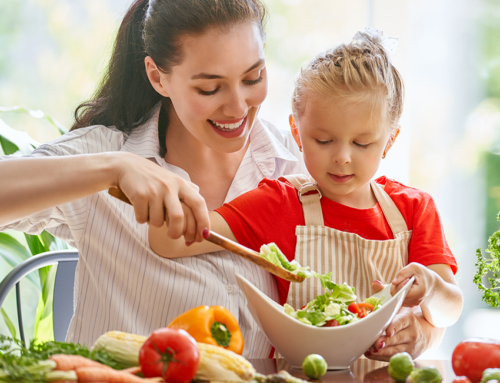9 Proven Grocery Store Advertising Ideas to Boost Your Business
In today’s hyper-competitive grocery market, staying ahead of the curve requires a solid marketing strategy that leverages modern channels and in-store advertising techniques to attract and retain customers. This blog post will explore nine proven grocery store advertising ideas that will not only help you boost your business but also create a memorable shopping experience for your customers. Get ready to learn new techniques for improving your grocery store’s performance and make your business thrive!
Key Takeaways
- To reach customers, use in-store marketing strategies and digital marketing channels.
- Utilize traditional methods such as print ads, direct mail campaigns, and radio advertising to optimize online shopping experiences.
- Leverage customer reviews & testimonials while offering eco-friendly alternatives & promoting sustainability initiatives for maximum impact.
1. Embrace Digital Marketing Channels for Grocery Store Promotion
With the world becoming increasingly digital, grocery stores must adapt and thrive by incorporating online marketing channels. Given that today’s customers largely depend on the internet for information, incorporating digital platforms such as social media, email, and search engine optimization (SEO) into grocery store marketing strategies will broaden your audience and amplify brand visibility.
Supermarket marketing strategies are essential for attracting customers and increasing sales. Grocery stores can prosper by executing targeted advertising efforts and offering discounts and promotions. Utilizing these digital platforms allows grocery stores to devise more impactful campaigns and engage more effectively with customers.
Social Media Marketing
Social media platforms like Facebook, Instagram, and Twitter have become powerful marketing tools for grocery stores. Maintaining a dynamic presence on these platforms enables customer engagement, sharing promotions, and product showcasing. Regular posting of engaging content such as:
- Videos
- Deals
- Seasonal offers
- Customer stories
- Recipes
- Food safety tips
will increase your brand’s visibility and help build a loyal customers. To encourage interaction with your social media page, consider running contests, offering giveaways, and providing rewards such as gift cards, special prize bundles, or discounts.
Investing in paid social media advertising can exponentially expand your reach to potential customers and improve your return on investment. Implementing these strategies can help you create a strong social media presence, drive sales, and foster customer loyalty.
Email Marketing
Email marketing offers numerous benefits for grocery stores, such as reaching a specified audience, increasing customer loyalty, and stimulating sales. To build a stronger relationship with your clients, switch from traditional weekly newspapers to emails for sharing special discounts, recipes, cooking advice, and weekly specials.
Small grocery stores can leverage email marketing to personalize offers by sending money-off coupons on regularly purchased items and crafting relevant offers based on previous purchases and customer preferences. By avoiding sending offers and promotions on things clients have not shown interest in, you can prevent your emails from being regarded as invasive.
Search Engine Optimization (SEO)
Search engine optimization (SEO) plays a critical role in enhancing your grocery store’s online visibility and attracting more customers. Utilizing SEO best practices can increase website traffic, improve search engine ranks, and produce more leads. These practices include keyword research, optimizing product titles and category names, and boosting page load speed.
Investing in SEO is a cost-effective way to grow your online presence and boost sales.
2. In-Store Advertising Techniques to Boost Sales
In-store advertising techniques play a vital role in boosting sales and enhancing the overall shopping experience. Strategic product placement, eye-catching digital signage, engaging sampling stations, and promotional pricing can significantly increase foot traffic, drive sales, and create lasting impressions on customers.
We’ll delve into these techniques with a finer level of detail.
Product Placement and Displays
Product placement and displays involve strategically positioning products in high-traffic areas of your store to encourage impulse purchases. Some tips for creating effective product displays include:
- Using vibrant colors and visual elements to catch customers’ attention
- Arranging products in an aesthetically pleasing way
- Maximizing the visibility of popular items by placing them in easily accessible and visible areas
By implementing these strategies, you can attract customers and increase sales.
In order to make the most of product placement and displays, consider analyzing your store layout, traffic flow, and sales data. Use this information to:
- Position popular and high-margin items near the entrance, endcaps, and checkout areas
- Cultivate a shopping environment that encourages customers to make additional purchases
- Boost your revenue
Digital Signage
Digital signage provides a dynamic and engaging way to showcase promotions, share store information, and enhance the shopping experience. Utilizing digital screens across your store to display promotional messages, including discounts, special offers, and new products, attracts customers and stimulates purchases.
In addition to promotions, digital signage can also be used to display store information such as store hours, location, and contact details. Furthermore, you can improve the overall shopping experience by offering interactive elements like product demonstrations, maps, and customer reviews.
Incorporating digital signage into your grocery store’s marketing strategy helps create an engaging, modern shopping ambiance that resonates with today’s tech-savvy consumers.
Sampling Stations
Sampling stations are designated areas within your local grocery store where customers can try products before purchasing them. Offering samples can boost sales by allowing customers to experience the taste and quality of products firsthand, leading to increased confidence in their purchase decisions.
To set up a successful sampling station, follow these steps:
- Select a high-traffic location.
- Create an attractive display.
- Provide knowledgeable staff at the station who can inform customers about the product and respond to their questions.
- Offer easy-to-transport samples that are representative of the product.
- Provide clear instructions on how to use the samples.
- Encourage customers to try the samples, as this will increase the likelihood of making a purchase.
By following these steps, you can create an effective sampling station that will attract customers and drive sales.
Sampling stations can be a powerful tool for driving sales and establishing a connection with your customers.
3. Local Community Engagement and Partnerships
Engaging with the local community and forming partnerships are essential for strengthening your brand’s reputation and attracting new customers. By sponsoring local events, collaborating with local producers, and hosting in-store events, you can create a strong connection with your community and showcase your commitment to supporting local causes and businesses.
We’ll delve further into these community engagement strategies.
Sponsor Local Events
Sponsoring local events is an effective way to raise brand awareness, foster relationships with the community, and generate positive publicity. By providing financial or in-kind support to local events, you can create promotional opportunities and demonstrate your dedication to the community.
When selecting events to sponsor, consider targeting:
- Nonprofit fundraising events
- Community food festivals
- Farmers’ markets
- School events
- Community charity events
Plan your sponsorship proposal carefully, outlining the benefits you can provide and negotiating the terms of the sponsorship to maximize your return on investment.
Sponsoring local events fosters a positive brand association, attracts new customers, and enhances sales.
Collaborate with Local Producers
Collaborating with local producers allows you to offer unique, locally sourced products while supporting the local economy and showcasing your commitment to the community. Forming ties with local producers allows you to give clients a variety of sustainable, artisanal food and farm-fresh products, giving you a competitive advantage.
There are several ways you can collaborate with local producers, such as offering their products in-store, implementing promotional campaigns to highlight local products, and forming partnerships to develop exclusive products. By working closely with local producers, you can create a stronger connection with your community while providing your customers with high-quality, unique products.
4. Host In-Store Events
Hosting in-store events can help you attract customers and create memorable experiences that will keep them coming back. You can hold a variety of events, for instance:
- Cooking classes
- Tastings
- Workshops
- Product launches
These events can generate excitement and encourage customers to visit your store. To ensure successful in-store events, follow these steps:
- Plan ahead and advertise the event well in advance.
- Make sure there is enough staff available to assist with the event and provide an excellent customer experience.
- Set a clear objective for the event.
- Assess the success of the event afterward to refine your event strategy and maximize the benefits of hosting future in-store events.
5. Implement a Loyalty Program to Retain Customers
Implementing loyalty programs is an effective way to retain customers and encourage repeat business, as repeat customers tend to spend up to 67% more than new customers. Offering a points-based system, tiered rewards, or personalized offers allows you to devise a loyalty program that resonates with your customers, encouraging their return.
We’ll examine these loyalty program options in greater depth.
Points-Based System
A points-based system is a loyalty program that rewards customers for their purchases, allowing them to accrue points that can be redeemed for exclusive discounts or other rewards. Customers can accumulate points through purchases made at your store, as well as through referrals and participation in special promotions.
When customers reach a certain point threshold, they can redeem their points for rewards such as discounts on future purchases or free products or services. A points-based system can help you cultivate customer loyalty and incentivize customers to increase their spending, benefiting both your customers and your business.
Tiered Rewards
Tiered rewards offer customers different levels of benefits and incentives based on their spending and loyalty to your store. Examples of tiered rewards programs in the grocery industry include:
- Albertsons for U
- Kroger Plus and Kroger Boost
- Walmart+
- Sprouts Farmers Market
Customers can unlock higher tiers of rewards by reaching specific spending thresholds, encouraging them to shop more frequently and spend more at your store. Tiered rewards can help you build lasting relationships with your most loyal customers while motivating others to increase their spending and loyalty.
Personalized Offers
Personalized offers are tailored to meet the individual needs of your customers, taking into account their preferences and past shopping behaviors. By providing personalized offers based on customer data, you can improve engagement and satisfaction while increasing sales and loyalty.
To create personalized offers, follow these steps:
- Collect data on customer preferences, shopping habits, and purchase history.
- Use this information to offer customers discounts on products they are likely to buy or unique offers for products they have previously purchased.
- Personalized offers can help you connect with your customers on a deeper level, increasing customer satisfaction and fostering long-term loyalty.
6. Utilize Traditional Advertising Methods for Maximum Reach
While digital marketing channels are essential, traditional advertising methods such as print ads, direct mail campaigns, and radio advertising still play an important role in reaching a broader audience and targeting specific demographics as part of overall marketing efforts.
Incorporating a blend of traditional advertising methods into your marketing strategy allows you to extend your reach and draw a wider range of customers.
Print Ads
Print ads in local newspapers and magazines are a cost-effective way to target potential customers in your area. By creating eye-catching and informative ads that showcase your products, promotions, and unique selling points, you can attract new customers and drive sales.
To maximize the impact of your print ads, choose publications that are popular among your target audience and ensure your ads are strategically placed for maximum visibility. Print ads can help you build brand recognition and reach customers who may not be active on digital channels.
Direct Mail Campaigns
Direct mail campaigns offer an effective way to engage potential customers and boost sales by targeting specific audiences with tailored offers and promotions. By sending coupons, promotional offers, and store information directly to customers’ mailboxes, you can create a personal connection and encourage them to visit your store.
To create a successful direct mail campaign, follow these steps:
- Segment your audience based on demographics, past behavior, and preferences.
- Tailor your content to connect with your audience and establish clear goals for your campaign.
- Measure the success of your campaign by tracking the number of coupons redeemed, new customers acquired, and the amount of revenue generated from the campaign.
You can use direct mail marketing strategies to promote sales by making personalized, targeted offers to clients who may not be active online.
Radio Advertising
Radio advertising is a powerful marketing tool for grocery stores because it has a broad audience and can target particular demographics. By creating engaging and informative radio ads that promote your store’s unique offerings, you can attract new customers and boost sales.
To optimize your radio advertising, follow these steps:
- Test different messages and formats.
- Track results and gather data.
- Use A/B testing to compare different versions of the ad and determine which one is more effective.
- Make adjustments based on the data collected.
By following these steps, you can improve the effectiveness of your radio advertising campaign.
By investing in radio advertising, you can reach a larger audience and drive sales, even among customers who may not be active on digital channels.
7. Optimize Your Online Shopping Experience
As online shopping becomes increasingly popular, it’s crucial to optimize your store’s online shopping experience to cater to customers’ preferences and busy schedules.
Designing a user-friendly website, providing convenient delivery and pickup options, and streamlining the checkout process helps to foster a seamless, enjoyable shopping experience that encourages customer return.
User-Friendly Website
A user-friendly website is essential for attracting and retaining online customers. Optimal website design techniques for grocery stores include:
- Mobile responsiveness
- Highlighting top products
- Incorporating a pop-up sign-up sheet
- Utilizing SEO best practices
By making your website easy to navigate and visually appealing, you can increase the likelihood that customers will find what they’re looking for and make a purchase. Emphasizing top products on your website can attract customers and encourage them to explore your offerings further, ultimately leading to increased sales.
Convenient Delivery and Pickup Options
Offering convenient delivery and pickup options is essential for catering to the diverse needs and preferences of your customers. By providing options such as curbside pickup, in-store pickup, and home delivery, you can make it easy for customers to shop at your store on their own terms.
By implementing a variety of delivery and pickup options, you can accommodate customers with busy schedules and demonstrate your commitment to customer satisfaction. This flexibility can help you attract new customers and retain existing ones, leading to increased sales and customer loyalty.
Streamlined Checkout Process
A streamlined checkout process is vital for reducing cart abandonment and improving the overall shopping experience. By simplifying the process and making it easy for customers to complete their purchase, you can increase the likelihood that they will return for future shopping trips.
You can ensure a smooth and efficient checkout experience for your customers, leading to increased satisfaction and customer loyalty.
8. Leverage Customer Reviews and Testimonials
Customer reviews and testimonials play a crucial role in building trust and credibility with potential customers. By encouraging customers to leave reviews, sharing positive testimonials, and responding to feedback, you can demonstrate your commitment to customer satisfaction and create a strong, trustworthy brand image.
Encourage Reviews
Customer reviews provide valuable insights into your customers’ experiences and opinions, helping you build trust and credibility with potential customers and identify areas for improvement. Incentivize customers to leave reviews by offering discounts, complimentary products, or loyalty program points. Provide direct links to review sites on your website and in your emails to make it easy for customers to share their feedback.
When responding to customer feedback, follow these guidelines:
- Be prompt and respectful.
- Acknowledge their input.
- Address any issues raised.
- Demonstrate that you value their opinion and are committed to providing excellent customer service.
Share Testimonials
Sharing positive customer testimonials on your website and social media channels can help showcase the satisfaction of your existing customers and build trust with potential customers. By highlighting real-life examples of customers who have had positive experiences with your store, you can demonstrate the value you bring to your customers and create a compelling case for choosing your store over competitors.
To share customer testimonials, you can incorporate them into your website design, create social media posts featuring customer stories, or include them in your marketing materials. By showcasing satisfied customers, you can strengthen your brand’s reputation and attract new customers.
Respond to Feedback
Responding to customer feedback is essential for demonstrating that you value their input and are committed to providing the highest quality of service. Ensure that you address both positive and negative feedback in a timely and respectful manner, acknowledging the feedback and addressing any issues raised.
By fostering open communication with your customers and actively addressing their concerns, you can:
- Build trust and credibility with potential customers
- Demonstrate your dedication to customer satisfaction
- Attract new customers
- Retain existing customers
This ultimately contributes to the overall success of your business.
9. Offer Eco-Friendly Alternatives and Promote Sustainability
In today’s environmentally-conscious world, offering eco-friendly alternatives and promoting sustainability can help attract customers who prioritize green initiatives.
Offering reusable bags and containers, initiating green measures in your store, and showcasing your dedication to the environment allows you to stand out from competitors and cultivate a loyal customer base.
Reusable Bags and Containers
Providing reusable bags and containers is an easy and effective way to reduce plastic waste and promote sustainable shopping habits among your customers. By offering branded reusable shopping bags and encouraging customers to use reusable containers for bulk items, you can demonstrate your commitment to the environment and set your store apart from competitors.
Consider partnering with local organizations or environmental groups to promote the use of reusable bags and containers and educate customers about the importance of reducing plastic waste. Taking these steps not only creates a positive impact on the environment but also draws environmentally-conscious customers to your store.
Green Initiatives
Implementing green initiatives in your store, such as energy-efficient lighting, recycling programs, and sourcing products from local suppliers, can help you demonstrate your commitment to the environment and attract customers who prioritize sustainability.
By promoting your green initiatives through in-store signage, social media, and promotional materials, you can raise awareness about your store’s eco-friendly practices and encourage customers to support businesses that prioritize sustainability. This can help you build a loyal customer base and differentiate your store from competitors in an increasingly environmentally-conscious market.
Summary
In conclusion, implementing a combination of digital marketing channels, in-store advertising techniques, community engagement strategies, loyalty programs, traditional advertising methods, and eco-friendly alternatives can significantly boost your grocery store’s business and create a loyal customer base. By adapting to modern marketing channels and focusing on customer satisfaction, your grocery store can thrive in today’s competitive market. It’s time to embrace these proven strategies and watch your business soar!











